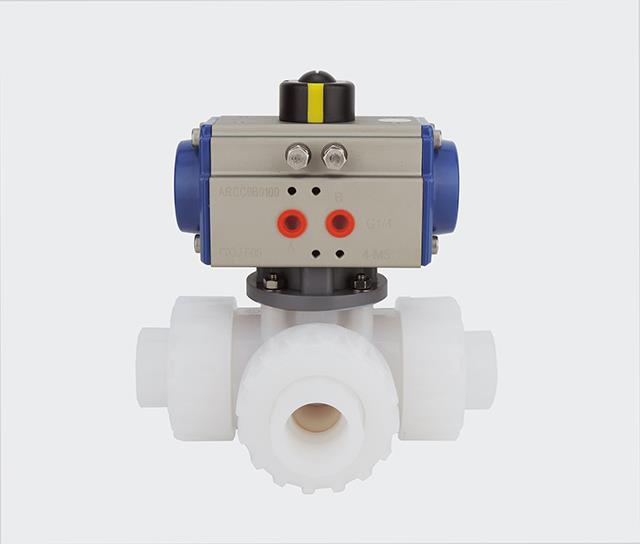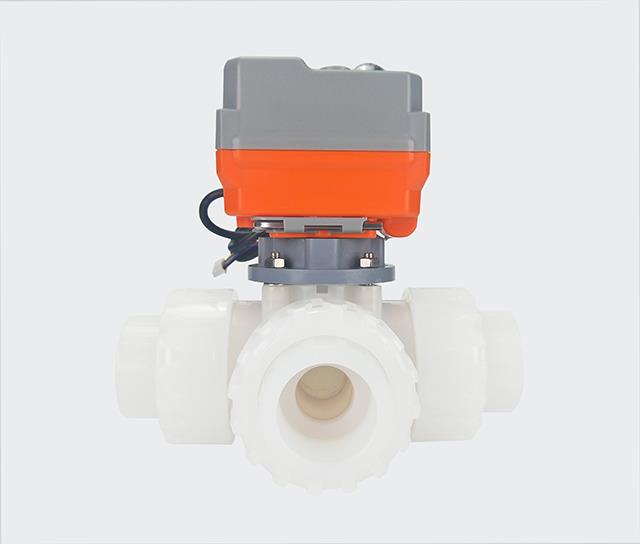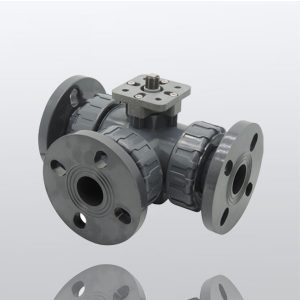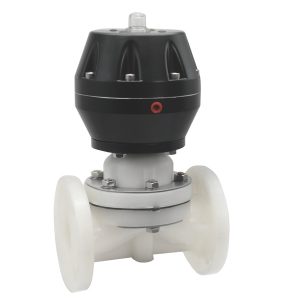PVDF ball valves are a highly specialized type of plastic valve designed for demanding industrial applications. Made from polyvinylidene fluoride, these valves stand out due to their exceptional chemical resistance, durability, and non-reactivity. Compared to other plastic ball valve options, such as PVC ball valves and CPVC ball valves. PVDF valves are better suited for handling aggressive chemicals and high-temperature environments.
While PVC ball valve and CPVC ball valve solutions provide cost-effective options for standard systems, PVDF excels in critical industries like chemical processing, water treatment, and pharmaceuticals. Their resistance to corrosive substances ensures long-lasting performance and low maintenance needs, even in the harshest conditions.
For applications requiring complex flow control, PVDF alternatives can be compared with three way ball valve PVC options. Though 3 way ball valve PVC designs offer flexibility in multi-port systems, PVDF may be preferred when chemical compatibility is paramount.
Whether you need a standard plastic valve or a robust solution like a PVDF ball valve, understanding your system’s requirements is essential. By choosing PVDF, industries can rely on superior chemical resistance, significant operational longevity, and lightweight yet durable performance for their critical applications.

Introduction
PVDF ball valves, made from polyvinylidene fluoride, are a specialized solution in the realm of industrial fluid handling, designed to meet the unique challenges of harsh and highly corrosive environments. PVDF is a thermoplastic fluoropolymer known for its outstanding chemical resistance, excellent durability, and non-reactivity. Which makes it especially valuable in industries where aggressive chemicals and extreme conditions are common. These valves stand out among other plastic options. Such as PVC and CPVC, due to their ability to operate reliably at higher temperatures and with more corrosive substances. Industries such as chemical processing, pharmaceuticals, and water treatment systems rely heavily on PVDF ball valves for their ability to maintain operational integrity where other materials might degrade or fail.
For example, in pharmaceutical production, where purity and contamination resistance are critical, PVDF demonstrates exceptional non-leaching properties. Similarly, in water treatment and chemical processing, its superior resistance to acids, bases, and solvents ensures consistent, long-lasting performance. Compared to alternative plastic valves, PVDF ball valves offer a more robust solution for critical applications. Combining lightweight construction with unmatched chemical compatibility and thermal endurance. These qualities not only reduce maintenance risks but also enhance the reliability and efficiency of complex industrial systems.
What is a PVDF Ball Valve?
PVDF (Polyvinylidene Fluoride) is a durable thermoplastic fluoropolymer known for its exceptional chemical resistance, thermal stability, and mechanical strength. Its ability to withstand aggressive chemicals and high temperatures makes it an ideal material for demanding applications like valve manufacturing, industrial coatings, and electrical components. Compared to other plastics like PVC or CPVC, PVDF offers superior performance in corrosive and high-heat environments. Ensuring longevity and reliability. However, it is generally more expensive, which may limit its use in cost-sensitive projects. Despite this, PVDF remains a top choice for industries requiring robust and non-reactive materials.
PVDF ball valves are engineered to excel in harsh industrial environments. Offering a combination of chemical resistance, durability, and non-reactivity that sets them apart from other materials. Their ability to resist a wide range of aggressive chemicals, such as acids, bases, and solvents. It makes them ideal for critical applications in chemical processing and water treatment facilities. The durability of PVDF ensures that these valves maintain their structural integrity and performance even when exposed to high pressures and temperatures. Reducing the risk of failure over time. Additionally, their non-reactive nature eliminates the likelihood of contamination or material degradation. A key requirement in industries like pharmaceuticals where maintaining process purity is essential. This robust construction not only extends the valve’s lifespan but also enhances overall reliability, ensuring efficient and uninterrupted operation in some of the most demanding industrial processes.
Comparison with Other Types of Plastic Valves——PVC Ball Valves and CPVC Ball Valves
PVC (Polyvinyl Chloride) and CPVC (Chlorinated Polyvinyl Chloride) ball valves differ primarily in their material composition, which impacts their performance and suitability for various applications. PVC is a widely used thermoplastic known for its affordability, versatility, and reliable chemical resistance. Making it ideal for low-pressure systems and general-purpose uses like irrigation, water distribution, and drain systems. On the other hand, CPVC undergoes an additional chlorination process, which enhances its thermal stability and chemical resistance, allowing it to handle higher temperatures and more corrosive substances. This makes CPVC valves a preferred choice for industries like chemical processing and hot water systems. Where durability under heat is crucial. While both materials are cost-effective, PVC is more budget-friendly and suitable for standard applications. Whereas CPVC justifies its slightly higher cost with superior strength in demanding environments. Together, PVC and CPVC ball valves offer adaptable solutions tailored to specific operational needs.

When comparing PVC, CPVC, and PVDF materials, it’s clear that PVDF stands out with its superior temperature and chemical resistance. PVC, while cost-effective and versatile, is limited in its ability to handle high temperatures or highly corrosive chemicals, making it suitable for standard water systems or drainage applications. CPVC, with its enhanced chlorination, improves upon PVC by offering greater thermal stability and the capacity to manage more aggressive substances, making it suitable for hot water systems or mild chemical handling.
However, PVDF surpasses both materials, thriving in demanding environments with extreme temperature fluctuations and exposure to highly corrosive or reactive chemicals, such as concentrated acids and solvents. This makes PVDF indispensable in industries like chemical processing, pharmaceuticals, and semiconductor manufacturing. While PVC and CPVC are more economical options, their performance cannot match the durability and reliability of PVDF. Which, despite its higher cost, proves to be a worthwhile investment for critical and high-stakes industrial applications.
Three Way Ball Valve PVC
A three-way ball valve in PVC design is a versatile component used in piping systems to manage flow direction efficiently. Its design incorporates a ball with three ports, allowing for multiple flow control options. Including diverting fluid to alternate pathways, mixing two flows, or completely shutting off the flow. This flexibility makes it ideal for complex systems requiring precise control. PVC as a material enhances the valve’s appeal. Offering excellent corrosion resistance, lightweight construction, and cost-effectiveness, coupled with ease of installation and maintenance. These features make three-way PVC ball valves a popular choice in applications such as irrigation systems, water treatment facilities, and chemical processing operations. Where both reliable performance and affordability are key considerations.
Three-way PVC ball valves and PVDF options provide distinct advantages for multi-port flow applications, shaped primarily by their material properties. PVC valves are highly cost-effective and lightweight, offering reliable performance in environments with moderate chemical exposure and lower temperature demands, such as irrigation, water distribution, and basic chemical handling. Their ease of installation and affordability make them an excellent choice for systems where budget constraints are critical. By contrast, PVDF three-way valves excel in challenging applications, boasting exceptional chemical resistance and the ability to withstand extreme temperatures and aggressive substances like concentrated acids or solvents. This makes them indispensable in industries such as chemical processing, pharmaceuticals, and semiconductor manufacturing where durability and reliability take precedence. While PVC valves are preferred for straightforward, cost-sensitive projects, PVDF valves justify their higher expense by delivering unmatched performance and longevity in critical, high-demand environments.
Applications of PVDF Ball Valves
PVDF valves excel in industries where operational conditions are demanding. Such as chemical processing, water treatment, and pharmaceuticals, due to their unique combination of chemical resistance, temperature tolerance, and durability. In chemical processing, their ability to handle aggressive substances like concentrated acids, solvents, and caustic solutions makes them indispensable for applications such as reaction vessels, pipelines, and waste handling. Similarly, in water treatment, PVDF valves perform reliably in corrosive environments, often exposed to chlorinated water and other harsh disinfectants. Ensuring efficient and uninterrupted flow control. The pharmaceutical industry benefits from PVDF’s non-reactive qualities, high purity, and ability to withstand sterilization processes. Making these valves ideal for managing sensitive fluids in production lines. These properties not only enhance reliability but also contribute to sustained efficiency in some of the most critical industrial operations.

Benefits of PVDF Ball Valves
PVDF ball valves offer significantly enhanced chemical resistance compared to other plastic options like PVC and CPVC. Making them the preferred choice for handling highly aggressive chemical environments. Unlike PVC and CPVC, which may deteriorate under prolonged exposure to concentrated acids, strong bases, or organic solvents. PVDF remains stable and resistant, even in extreme conditions. This robust chemical compatibility ensures greater longevity and reliability in critical industrial applications, such as chemical plants, pharmaceutical manufacturing, and semiconductor processes. While PVDF valves come at a higher cost, their ability to withstand harsh substances without compromising performance justifies this investment, particularly in settings where operational integrity and safety are paramount. This superior chemical resistance reduces maintenance needs and minimizes the risk of system failure, making PVDF a long-term, cost-effective solution despite its initial expense.
PVDF valves are renowned for their longevity and low maintenance in demanding environments. Thanks to their exceptional material properties like high chemical resistance and temperature tolerance. These qualities ensure that PVDF valves can withstand prolonged exposure to aggressive chemicals, extreme temperatures, and harsh operational conditions without deterioration. This durability minimizes the need for frequent maintenance and replacements. Reducing downtime and long-term costs. Industries such as chemical processing, pharmaceuticals, and water treatment particularly benefit from these advantages. As PVDF valves maintain reliable performance even when handling corrosive substances, sterilization processes, or water containing harsh disinfectants. By ensuring prolonged operational integrity, PVDF valves provide a cost-effective and dependable solution in critical applications where efficiency and reliability are paramount.
Maintenance Tips for PVDF Ball Valves
To ensure the longevity and optimal performance of PVDF valves, a consistent cleaning and upkeep checklist is essential. Begin with regular inspections to identify any signs of wear, damage, or build-up that could impede functionality. Clean valves periodically to remove chemical residues using cleaning agents specifically compatible with PVDF to prevent material degradation. Pay special attention to aggressive substances that may have accumulated on internal surfaces. Lubricate moving parts as needed to maintain smooth operation, ensuring the lubricant is suitable for use with PVDF materials. Verify that seals and gaskets are secure and intact to prevent leaks. Following this checklist not only extends the valve’s lifespan but also minimizes downtime and preserves reliability in critical industrial applications, from chemical processing to water treatment operations.
Regular inspections of seals and connections in PVDF valves are vital for maintaining operational reliability, especially in high-stakes industries like chemical processing and water treatment. Begin by visually inspecting seals for signs of wear, cracks, or deformation, as these could compromise their integrity. Check the connections to ensure they are tight and secure, taking care to use appropriate tools to avoid overtightening or damaging the valve components. Conduct leak tests by gradually applying pressure or introducing a small flow of fluid through the system, monitoring for any seepage or drips. If issues are detected, replace the seals or retighten connections as necessary, following manufacturer guidelines. Regular inspections like these not only prevent unexpected system failures but also contribute to the valve’s longevity, reducing downtime and maintenance costs in demanding operations.
FAQ
1. What sizes are available for PVDF ball valves?
PVDF ball valves are available in a range of sizes, typically starting from 1/2 inch (DN15) up to 4 inches (DN100). Custom sizing may be available depending on the manufacturer.
2. Where are PVDF ball valves typically used?
These valves are commonly utilised in industries such as:
Chemical Processing
Water Treatment Plants
Pharmaceutical Manufacturing
Oil & Gas Applications
Semiconductor Fabrication

3. How do you maintain a PVDF ball valve?
Maintenance is minimal with PVDF ball valves as their non-reactive surface prevents scaling and corrosion. However, regular inspections for wear, leakage, and proper operation are recommended to ensure optimal performance over time.
4. Are PVDF ball valves suitable for high-pressure systems?
Yes, PVDF ball valves are designed to handle moderate to high-pressure systems, with pressure ratings typically varying between 10 and 16 bar depending on the valve’s design and size.
Conclusion
PVDF ball valves stand out among plastic valve options due to their superior chemical resistance, exceptional temperature tolerance, and remarkable durability. These features make them particularly well-suited for demanding applications in industries. Such as chemical processing, pharmaceuticals, and water treatment, where reliability is critical. While their upfront cost may be higher compared to alternatives like PVC or CPVC, their long-term cost-effectiveness is undeniable. Thanks to minimal maintenance requirements, reduced downtime, and an extended operational lifespan. By offering unmatched performance in even the harshest environments, PVDF ball valves provide a dependable solution for industrial processes where efficiency and resilience are non-negotiable.
PVDF ball valves are an indispensable asset in modern industrial applications, offering unparalleled reliability in challenging environments. Their ability to withstand harsh chemicals, high temperatures, and demanding operational conditions ensures consistent performance across a wide range of processes. By reducing maintenance demands and minimizing downtime, they provide a cost-effective solution that supports sustainable and efficient operations. Industries such as chemical processing, pharmaceuticals, and water treatment benefit significantly from their durability and resistance to corrosion. Making these valves a trusted choice for critical systems. For any application where precision, longevity, and performance are paramount, PVDF ball valves are an investment in operational excellence.
